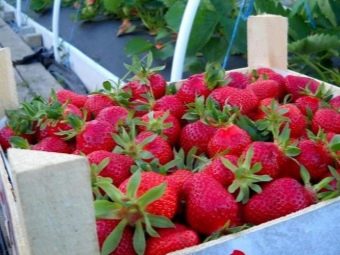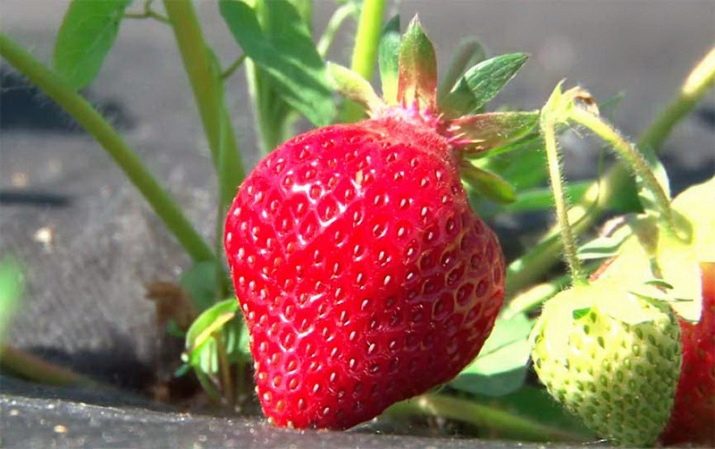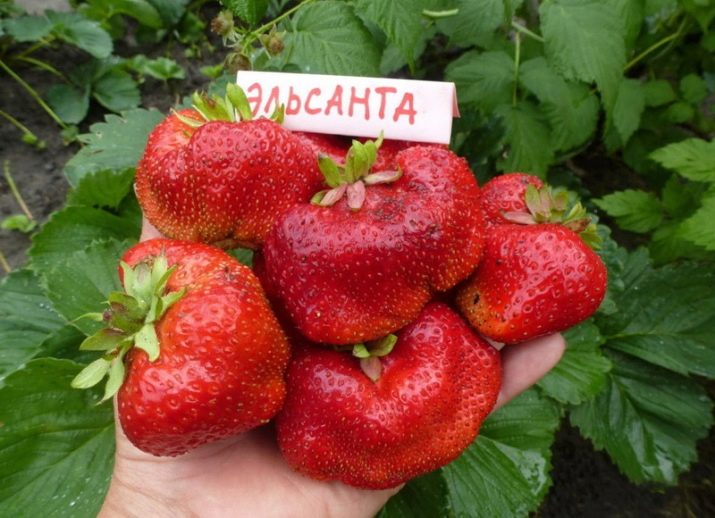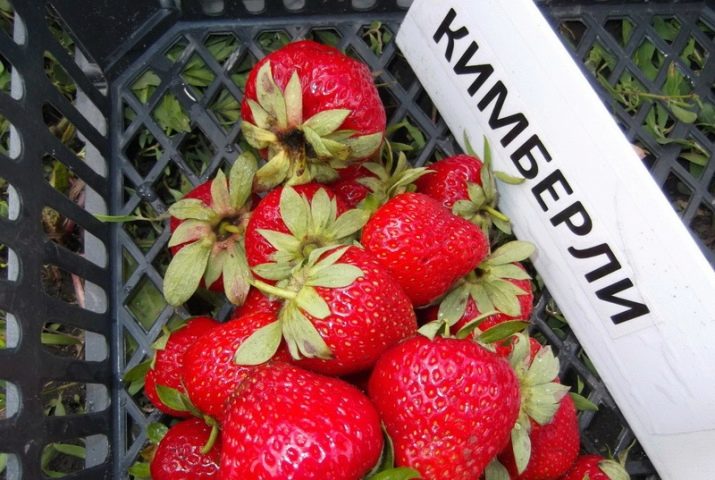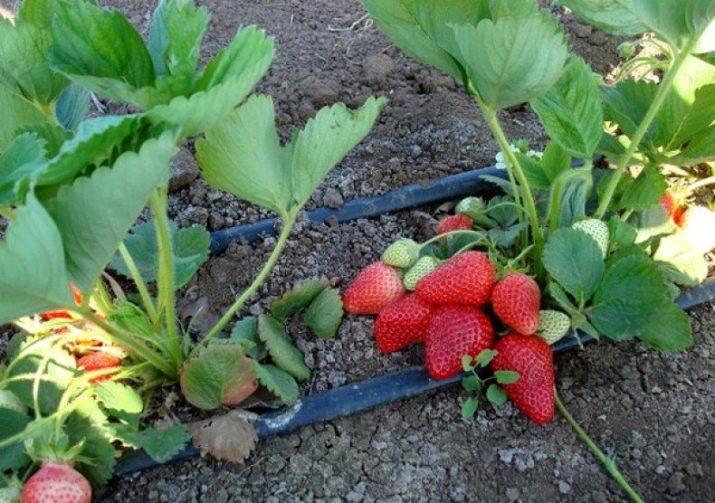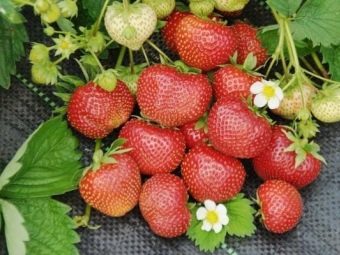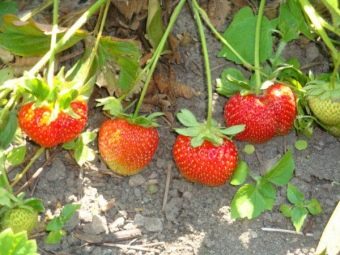The best early strawberry varieties
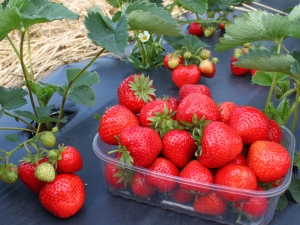
In the spring after a long winter, you want to eat the first fragrant berry, especially if it is grown in your own summer cottage. And this is quite possible, since the breeders brought out many early varieties of strawberries, ripening even in May.
Advantages and disadvantages
Early varieties gained wide popularity due to their undoubted advantages:
- they begin to produce crops already in the 2nd decade of May;
- the size of the berries and their palatability are not affected by the lack of sun and heat in early spring during the growing season;
- almost all early varieties have the ability to self-pollinate;
- early strawberry fruits for almost a month;
- a wide variety of varieties, including zoned for different regions;
- excellent resistance to cold and disease;
- adapted to spring temperature jumps.
The disadvantage is that these varieties require care according to all the rules of agricultural engineering, and, consequently, a large investment of labor. These are the general advantages of early varieties, but each individual variety has its pros and cons.
Varieties
All early strawberries are subdivided into superearly, early and medium-early varieties.
Superearly
Super early strawberries can be planted in the period from April 1 to April 15 in accordance with weather conditions. When planting strawberries, you need to calculate that it will bloom when the light day is longer than 8 hours. Only then the berry will be formed in a month and a half from the moment of its planting.
Italian strawberry "Alba"
Its peculiarity is that it begins to bloom a little later, which means that possible spring frosts will not harm it. And the berries ripen even before other superearred varieties.
Fruit ripening occurs in the last days of May. In the south of the country, the crop ripen even in the second decade of April. Oval scarlet "Alba" berries, reaching 25-30 g of weight, are quite large. “Alba” is different in that the fruits retain their size during the entire harvest season.
Their taste is also at a high level: the sweet flesh is very juicy with a little sourness. The largest crop belongs to the best of the super early, since the bush produces an average of 500 g-1.5 kg of strawberries. “Alba” does not suffer from mealy dew.
Olbia
It is a reliable variety of Ukrainian breeders. Berries ripen around May 15th.
Olbia has large, about 40 g in size, rounded fruits with a bright red color. The juicy pulp has a dense and sweet texture. With favorable care can give up to 2 kg of fruit from the bush. It is transported without large losses and is stored for a long time. Not afraid of frost, has resistance to fungal diseases.
Honey
This is a variety of American breeders, known since the late 70s of the XX century. Proven by time and successfully cultivated not only at home but also in other countries.
Strawberry “Honey” is unpretentious in cultivation and care, rarely gets sick and is characterized by stability of the crop, which can ripen even in the first decade of May under the condition of warm weather. With favorable care can bring three crops per season. The productivity of the bush is about 1 kg.
Oblong conical strawberry of a dark red shade is rather large (from 20 to 40 g), the flesh has a soft, sweet and juicy structure. The fruits of the last harvest become smaller, but the taste, on the contrary, is brighter.
Dutch Elsanta
"Elsanta" - the standard of strawberry varieties, to the criteria of which breeders strive. She has an exceptionally juicy and slightly sour sweetness. Brilliant fruits are large and weigh up to 40 g. However, Elsanta is exposed to infections when cultivated in the middle belt. It is also demanding on the rules of irrigation and does not tolerate any excess or lack of moisture.
Fruiting high - strawberry bush can produce up to 1.5 kg of fruit.
"Marvelous"
This is a Russian variety. Well endured cold and dry weather.
Its oblong fruit in the form of a cone can reach 35 g of weight.Strawberry flavor is present in its dense, but sweet pulp. The yield of crop is 1 kg from each bush.
For a long time and without damage to the crop, it has been constantly growing on the site for about four years. “Marvelous” does not infect with gray rot, but suffers from purple spot and infects with spider mites.
There are other superearly varieties: "Rosinka", "Zephyr", "Christina", "Desna" and many others.
Early
Early varieties include strawberries, the harvest of which ripens after May 15 - to the beginning of June.
"Masha"
"Masha" belongs to the best early strawberry varieties. She is a record holder in the size of fruits, the maximum weight of which in the first harvest reaches 100 g. In the following collections the fruits are already smaller - 30-40 g.
Its brilliant berry of bright red color with a comb-like, slightly flattened shape has a juicy sweet pulp structure with a slight wateriness. Productivity is high, about 800 g from a bush. Masha has immunity to fungal infections; she is not capricious in cultivation.
However, its disadvantage is poor frost resistance. Strawberries do not survive frosts below -15 degrees.
"Moscow"
Moskovskaya has medium-sized thick red hues and taut sour-sweet pulp. Regularly fruits in conditions of good care.
It is unpretentious to the soil, grows on lands of any kind, but the harvest is higher on fertile. Not afraid of frost.
"Vibrant"
"Vibrant" - English early ripe grade of strawberry. Fruits with a thick red tinge have a flesh with a dense structure.
Does not suffer from powdery mildew, unpretentious to the composition of the soil.
"Kama"
Representative of the Polish strawberry. When cultivated on open ground, the first harvest of fruits is possible in the last days of May. Duration of fruiting is about a month. The first berries are large, the next - smaller. The productivity of a strawberry bush is about 1 kg.
Strawberries are immune to fungal infections and rot, and there is no resistance to ticks and blotches. Demanding watering and sunlight.
Medium early
Middle-early strawberries begin to bear fruit in the 2nd decade of May to the 1st decade of June.
Kimberly
Relatively young Dutch strawberry mid-ripening. It affects the size (up to 50 g) of its fruits with a heart shape and a special sweet-caramel flavor of the pulp.
The disadvantage is poor tolerance to drought, demands in regular watering, as well as the ability to produce a lot of mustaches that require constant removal. Yields give high - 1-2 kg per bush.
"Kokinskaya"
Strawberry Russian selection. A variety of medium early ripening, the berries of which are harvested throughout June.
Saturated red fruits in the form of a blunt cone, though not allocated a large amount (only 10-15 g), but have a wonderful fragrant sweet-strawberry flavor. Crops reach 800 g per plant.
It is not exposed to many infections, but it needs to be covered during frosty and snowless winters.
"Darenka"
Also a variety of Russian selection, well adapted to Russian weather conditions. The size of the fruit can be large (30 g), and medium. The fruits in the shape of a cone with a rounded end have a peculiar neck on top. The flesh though sweet, but slightly sour.
"Darenka" is perfectly experiencing cold and temperature drops in the spring. Not capricious when growing, but loves regular watering.
"Asia"
This is a relatively young Italian strawberry variety, created in 2005. Bright red juicy berries with elastic pulp inherent strawberry flavor. Cone-shaped strawberries can weigh 20-35 g. It is resistant to fungal diseases of the roots.
The list with the names of the early varieties does not end there, there are a huge number of them with berries of different shapes, different shades of red and nuances of taste.
Which prefer in different regions?
Strawberries are cultivated for a very long time, during which a huge number of varieties have been bred.But there is no such universal variety that would fit any climate or soil type.
However, breeders have created many zoned varieties that are suitable for cultivation in the area and in this climate. Therefore, choosing a grade, it is necessary to prefer them.
For central Russia
The average Russian strip is characterized by a moderately continental climate: cold and snowy winters and a warm wet summer season.
Farmers here often face such problems:
- early autumn and late-spring frosts;
- late spring;
- heavy rains, which can alternate with drought;
- poor soil.
Therefore, strawberries grown in such conditions should have:
- frost resistance;
- ability to tolerate moisture deficiency:
- undemanding of soil types;
- immunity to disease;
- early maturation.
Based on the experience of amateur gardeners and specialists, the Zenga-Zengana, Festivalnaya, Kokinskaya, Lord varieties are suitable for better cultivation in this area.
"Zeng-Zengana"
“Zenga-Zengana” was created by German specialists and has a late maturity. A beautiful view of large glossy berries of a thick red tint has an exceptional taste of juicy-aromatic pulp, gives regular and fairly high yields. Resistant to major strawberry infections. Withstands great cold, well experienced a lack of moisture.
"Lord"
English strawberries, created in the second half of the twentieth century, are considered to be mid-late.
In the scarlet color of the berries with a rounded conical shape elastic pulp. In very large berries, which can grow to 100 g, voids are formed. The taste of the berries depends on the weather: they are sweet in hot, and sour taste appears in rainy and overcast.
"Festival"
It is an old and widespread Russian variety. The size of saturated red shiny fruits changes during the fruiting period: from large at first (approximately 45 g) to small (up to 10 g) at the end, but the yield does not decrease. It has excellent taste properties and is immune to infections.
“Talisman”, “Zarya”, “Early Maherauha”, “Elsanta”, “Kiss Nellis” “Darselect” and others are also recommended for the middle band.
For Moscow region
The Moscow region is characterized by the instability of weather in spring and autumn, possible frosts, which is taken into account when selecting strawberries. In Moscow region, berries of both early and late ripening are successfully cultivated.
Strawberries, zoned for the region:
- "Queen Elizabeth" - early-ripening variety, characterized by high yield, remarkable taste characteristics, high cold resistance (not afraid of frost down to -25), undemanding to the soil.
- "Sonata" - medium early variety. Tolerant of any kind of soil, but fructification is higher on fertile lands. For the "Sonata" is characterized by beautiful shiny conical fragrant fruit.
Other early varieties have been zoned for the Moscow region: “Anita”, “Alba”, “Deroyal”, “Cardinal”, “Kent”, “Moscow delicacy”.
For the Urals
The climate features of the Urals impose the following requirements for strawberry varieties:
- early ripening, as in the Urals a short summer period;
- high resistance to frost - the winter is harsh here;
- resistance to overmoistening of the soil and air: in the Urals with prolonged summer rains comes a decrease in temperature, the soil is saturated with moisture;
- immunity to fungal and bacterial infections.
Strawberry varieties for the Urals should have time to ripen until the first half of July, since then the rainy season begins.
Recommended varieties:
- "Maria" - Early strawberries, flowers that stand frost. The fruits are large, sweet, with a pleasant sourness. It meets climatic requirements and is resistant to strawberry infections.
- "Amulet" - dessert, with sugar fruits, early-ripening variety. Fruits are large (up to 30 g), yield - about 2 kg per plant."Amulet" is frost-resistant, has immunity to major infections.
The following varieties are also zoned for the Urals:
- "Ruby Pendant" - universal strawberry, giving great harvests;
- "Festival chamomile" - variety of medium early ripening;
- late - “Temptation”, “Beauty Zagorje”; remontant "Lord".
For the Leningrad region
The climate peculiarity of the Leningrad Region is distinguished by instability of the weather, increased humidity, late and sluggish spring with recurrent frosts. Strawberries are recommended especially for the Leningrad region.
- "Sudarushka" - an early variety with high yields of berries, which are characterized by large size and sweet-sour taste. It has excellent frost resistance and good disease resistance.
- "Queen" - This is a large-fruited variety. At the beginning of fruiting, the fruits are about 50 g, but the size of the crop is not very large. The variety has good immunity to strawberry fungal diseases, it tolerates hot and frosty weather, but requires shelter in the freezing cold.
In addition, the varieties are well cultivated: “Junia Smides”, “Zarya”, “Tsarskoselskaya”, “Onega”, “Festival” and others.
For Udmurtia
The climate of Udmurtia is distinguished by frosty snowy winters and hot summer periods. Gardeners of Udmurtia prefer to grow remontant varieties of strawberries.
- "Geneva" - remontant strawberries with large berries (up to 50 g) of sweet taste. The variety is frost resistant, with immunity to many strawberry diseases.
- Tristar - also a remontant variety, with an exceptional taste of juicy sugar fruits. In the summer there are two crops.
In addition to these, the following varieties are successfully cultivated in Udmurtia: Borovitskaya, Darenka, Talka, Cinderella, Polka.
Gardeners reviews
Summer residents often recommend the strawberry “Chosen One” for breeding in the middle Russian strip. First of all, its stable and high yields, remarkable taste properties are noted. By immunity to disease and frost resistance, it corresponds to the climatic conditions of this region.
There are also many positive reviews about such varieties:
- "Marvelous" for its fragrant and sweet berries;
- "Clery" for unpretentiousness in leaving;
- "Kimberley" for winter hardiness and the size of the berries;
- "Darlelekt" - note its yield and great taste, but with one drawback - a strong absorption of energy;
- "Lord" - great taste, cold resistance and the ability to be stored for a long time.
For information on which early strawberry varieties are best grown, see the following video.



